Progressive music
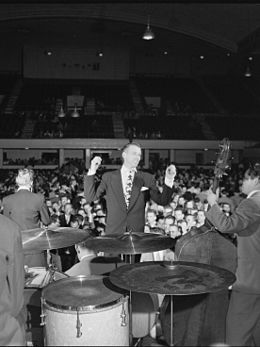
Progressive musicis music that attempts to expand existing stylistic boundaries associated with specificgenresof music.[2]The word comes from the basic concept of "progress",which refers to advancements through accumulation,[3]and is often deployed in the context of distinct genres, withprogressive rockbeing the most notable example.[4]Music that is deemed "progressive" usually synthesizes influences from various cultural domains, such as Europeanart music,Celtic folk,West Indian,orAfrican.[5]It is rooted in the idea of acultural alternative,[6]and may also be associated withauteur-starsandconcept albums,considered traditional structures of themusic industry.[7]
As anart theory,the progressive approach falls betweenformalismandeclecticism.[8][9]"Formalism" refers to a preoccupation with established external compositional systems, structural unity, and the autonomy of individual art works. Like formalism, "eclecticism" connotes a predilection toward style synthesis or integration. However, contrary to formalist tendencies, eclecticism foregrounds discontinuities between historical and contemporary styles andelectronic media,sometimes referring simultaneously to vastly different musical genres, idioms, andcultural codes.[10]Inmarketing,"progressive" is used to distinguish a product from "commercial"pop music.[11]
Jazz
[edit]Progressive jazzis a form ofbig bandthat is more complex[12]or experimental.[1]It originated in the 1940s with arrangers who drew frommodernistcomposers such asIgor StravinskyandPaul Hindemith.[12][nb 1]Its "progressive" features were replete with dissonance, atonality, and brash effects.[14]Progressive jazz was most popularized by the bandleaderStan Kentonduring the 1940s.[12]Critics were initially wary of the idiom.[12]Dizzy Gillespiewrote in his autobiography: "They tried to make Stan Kenton a 'white hope', called modern jazz and my music 'progressive', then tried to tell me I played 'progressive' music. I said, 'You're full of shit!' 'Stan Kenton? There ain't nothing in my music that's cold, cold like his."[15]
Progressive big bandis a style of big band orswing musicthat was made for listening, with denser, more modernist arrangements and more room to improvise. The online music guideAllMusicstates that, along with Kenton, musicians likeGil Evans,Toshiko Akiyoshi,Cal Massey,Frank Foster,Carla Bley,George Gruntz,David Amram,Sun Ra,andDuke Ellingtonwere major proponents of the style.[16]
Pop and rock
[edit]Definitions
[edit]"Progressive rock" is almost synonymous with "art rock";the latter is more likely to have experimental or avant-garde influences.[17]Although a unidirectional English "progressive" style emerged in the late 1960s, by 1967, progressive rock had come to constitute a diversity of loosely associated style codes.[9][nb 2]With the arrival of a "progressive" label, the music was dubbed "progressive pop"before it was called"progressive rock".[19][nb 3]"Progressive" referred to the wide range of attempts to break with the standard pop music formula.[21]A number of additional factors contributed to the label—lyrics were more poetic, technology was harnessed for new sounds, music approached the condition of "art", some harmonic language was imported from jazz and19th-century classical music,the album format overtook singles,and the studio, rather than the stage, became the focus of musical activity, which often involved creating music for listening, not dancing.[22]
Background
[edit]Up until the mid 1960s, individual idiolects always operated within particular styles. What was so revolutionary about this post-hippiemusic that came to be called 'progressive'... was that musicians acquired the facility to move between styles—the umbilical link between idiolect and style had been broken.
—Allan Moore[19]
During the mid 1960s, pop music made repeated forays into new sounds, styles, and techniques that inspired public discourse among its listeners. The word "progressive" was frequently used, and it was thought that every song and single was to be a "progression" from the last.[23]In 1966, the degree of social and artistic dialogue among rock musicians dramatically increased for bands such asthe Beach Boys,the Beatles,andthe Byrdswho fused elements ofcomposed (cultivated) musicwith theoral (vernacular) musical traditionsof rock.[3]Rock music started to take itself seriously, paralleling earlier attempts in jazz (as swing gave way to bop, a move which did not succeed with audiences). In this period, thepopular songbegan signaling a new possible means of expression that went beyond the three-minutelove song,leading to an intersection between the "underground" and the "establishment" for listening publics.[24][nb 4]The Beach Boys' leaderBrian Wilsonis credited for setting a precedent that allowed bands and artists to enter a recording studio and act as their own producers.[26]
The music was developed immediately following a brief period in the mid 1960s where creative authenticity among musical artists and consumer marketing coincided with each other.[27]Before the progressive pop of the late 1960s, performers were typically unable to decide on the artistic content of their music.[28]Assisted by the mid 1960s economic boom, record labels began investing in artists, giving them freedom to experiment, and offering them limited control over their content and marketing.[11][nb 5]The growing student market serviced record labels with the word "progressive", being adopted as a marketing term to differentiate their product from "commercial" pop.[11]Music criticSimon Reynoldswrites that beginning with 1967, a divide would exist between "progressive" pop and "mass/chart" pop, a separation which was "also, broadly, one between boys and girls, middle-class and working-class".[30][nb 6]Before progressive/art rock became the most commercially successful British sound of the early 1970s, the 1960spsychedelic movementbrought together art andcommercialism,broaching the question of what it meant to be an artist in a mass medium.[31]Progressive musicians thought that artistic status depended on personal autonomy, and so the strategy of "progressive" rock groups was to present themselves as performers and composers "above" normal pop practice.[32][nb 7]
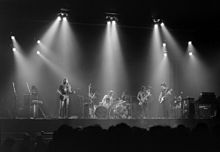
"Proto-prog"is a retrospective label for the first wave of progressive rock musicians.[35]The musicians that approached this genre harnessedmodern classicaland other genres usually outside of traditional rock influences, longer and more complicated compositions, interconnected songs as medley, and studio composition.[36]Progressive rock itself evolved frompsychedelic/acid rockmusic,[3]specifically a strain of classical/symphonic rock led bythe Nice,Procol Harum,andthe Moody Blues.[17][nb 8]Critics assumedKing Crimson's debut albumIn the Court of the Crimson King(1969) to be the logical extension and development of late 1960s proto-progressive rock exemplified by the Moody Blues, Procol Harum,Pink Floyd,and the Beatles.[37]According to Macan, the album may be the most influential to progressive rock for crystallizing the music of earlier "proto-progressive bands [...] into a distinctive, immediately recognizable style".[38]He distinguishes 1970s "classic" prog from late 1960s proto-prog by the conscious rejection of psychedelic rock elements, which proto-progressive bands continued to incorporate.[39]
Post-progressive
[edit]"Post-progressive"is a term invented to distinguish a type of rock music from the persistent" progressive rock "style associated with the 1970s.[40]In the mid to late 1970s, progressive music was denigrated for its assumed pretentiousness, specifically the likes ofYes,Genesis,andEmerson, Lake & Palmer.[41]According to musicologist John Covach, "by the early 1980s, progressive rock was thought to be all but dead as a style, an idea reinforced by the fact that some of the principal progressive groups has developed a more commercial sound. [...] What went out of the music of these now ex-progressive groups [...] was any significant evocation of art music."[42]In the opinion of King Crimson'sRobert Fripp,"progressive" music was an attitude, not a style. He believed that genuinely "progressive" music pushes stylistic and conceptual boundaries outwards through the appropriation of procedures from classical music or jazz, and that once "progressive rock" ceased to cover new ground – becoming a set of conventions to be repeated and imitated – the genre's premise had ceased to be "progressive".[43]
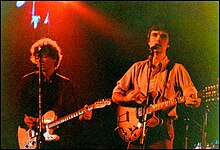
A direct reaction to prog came in the form of thepunk movement,which rejected classical traditions,[41]virtuosity, and textural complexity.[42][nb 9]Post-punk,which author Doyle Green characterizes "as a kind of'progressive punk'",[44]was played by bands likeTalking Heads,Pere Ubu,Public Image Ltd,andJoy Division.[41]It differs from punk rock by balancing punk's energy and skepticism with a re-engagement with anart schoolconsciousness,Dadaistexperimentalism, and atmospheric, ambient soundscapes. It was also majorly influenced fromworld music,especially African and Asian traditions.[41]In the same period,new wave musicwas more sophisticated in production terms than some contemporaneous progressive music, but was largely perceived as simplistic, and thus had little overt appeal to art music or art-music practice.[42]MusicologistBill Martinwrites; "[Talking] Heads created a kind of new-wave music that was the perfect synthesis of punk urgency and attitude and progressive-rock sophistication and creativity. A good deal of the more interesting rock since that time is clearly 'post-Talking Heads' music, but this means that it is post-progressive rock as well."[45]
Soul and funk
[edit]
"Progressive soul" is used by Martin to refer to a musical development in which many African-American recording artists by the 1970s were creating music in a manner similar to progressive rock.[46]This development inspired greater musical diversity and sophistication, ambitious lyricism, and conceptual album-oriented approach in black pop.[47]Among the musicians at its forefront wereSly Stone,Stevie Wonder,Marvin Gaye,Curtis Mayfield,andGeorge Clinton.[48]According toGeoffrey Himes,"the short-lived progressive-soul movement flourished" from 1968 to 1973 and demonstrated "adventurous rock guitar, socially conscious lyrics and classic R&B melody".[49]Similar to contemporaneous white prog musicians, progressive black musicians in the 1970s directed their creative control toward ideals of "individualism, artistic progression and writing for posterity", according to music academic Jay Keister, who notes that this pursuit sometimes conflicted with the collective political values of theBlack Arts Movement.[50]
Among the stylistic characteristics shared from progressive rock in black progressive music of this period were extended composition, diverse musical appropriation, and recording music intended for listening rather than dancing. Rather than the song-based extended compositions and suites of progressive white music, black counterparts in the 1970s generally unified an extended recording with an underlying rhythmicgroove.Instrumental textures were altered in order to signify a change in section over an extended track's course. Examples of these characteristics includeFunkadelic's "Wars of Armageddon" (1971) andSun Ra's "Space Is the Place"(1973).[51]Unlike the European art music appropriations used by white artists, progressive black music featured musical idioms fromAfricanandAfrican-American musicsources. However, some also borrowed elements from European American traditions to augment a song's lyrical idea. For example, Wonder added pleasant-sounding instrumental textures from a string section to "Village Ghetto Land" (1976), lending a sense of irony to an otherwise bleak critique of social ills in urban ghettos.[52]
Electronic
[edit]"Progressive electronic"is defined by AllMusic as a subgenre ofnew age music,and a style that "thrives in more unfamiliar territory" where the results are "often dictated by the technology itself". According to Allmusic, "rather than sampling or synthesizing acoustic sounds to electronically replicate them" producers of this music "tend to mutate the original timbres, sometimes to an unrecognizable state". Allmusic also states that "true artists in the genre also create their own sounds".[53]
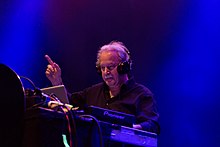
Tangerine Dream's 1974 albumPhaedra,recorded with aMoogsequencer, was described as "an early masterpiece of progressive electronic music" byRolling Stone.[54]Inhouse music,a desire to define precise stylistic strands and taste markets saw the interposition of prefixes like "progressive", "tribal",and"intelligent".According to disc jockey and producerCarl Craig,the term "progressive" was used inDetroitin the early 1980s in reference toItalian disco.The music was dubbed "progressive" because it drew upon the influence ofGiorgio Moroder'sEuro discorather than the disco inspired by the symphonicPhiladelphia sound.[55]By 1993,progressive houseandtrance musichad emerged indance clubs.[56]"Progressive house" was an English style of house distinguished by long tracks, big riffs, mild dub inflections, and multitiered percussion. According to Simon Reynolds, the "'progressive' seemed to signify not just its anti-cheese, nongirly credentials, but its severing of house's roots from gay black disco".[57]
In the mid-1990s, thelowercasemovement, a reductive approach towards new digital technologies, was spearheaded by a number of so-called "progressive electronica"artists.[58]
Criticism
[edit]Reynolds[59]posited in 2013 that "the truly progressive edge in electronic music involves doing things that can't be physically achieved by human beings manipulating instruments in real-time".[59]He criticized terms like "progressive" and "intelligent", arguing that "it's usually a sign that it's gearing up the media game as a prequel to buying into traditional music industry structure of auteur-stars, concept albums, and long-term careers. Above all, it's a sign of impending musical debility, creeping self-importance, and the hemorrhaging away of fun."[60]Reynolds also identifies links between progressive rock and other electronic music genres, and that "many post-ravegenres bear an uncanny resemblance to progressive rock: conceptualism,auteur-geniuses,producers making music to impress other producers, [and] showboating virtuosity reborn as the 'science' of programming finesse ".[61]
Hip hop
[edit]"Progressive rap"has been used by academics to describe a certain type ofhip hop music.Anthony B. Pinnregards it as a thematic subset alongsidegangsta rapand "status rap", which expresses concerns aboutsocial statusandmobility.While exploringexistential crisesand philosophical contradictions similar to gangsta rap, progressive rap, he says, "seeks to address these concerns without intracommunal aggression and in terms of political and cultural education, providing an interpretation of American society and a constructive agenda (e.g. self respect, knowledge, pride, and unity) for theupliftofBlack America".He adds that works of the genre also utilize" a more overt dialogue with and interpretation ofBlack religiosity".[62]In a corollary analysis, fellow academic Evelyn L. Parker says that progressive rap "seeks to transform systems of injustice by transforming the perspective of their victims" while demonstrating "the clear prophetic voice reflecting the rage caused by the dehumanizing injustices that African Americans experience".[63]
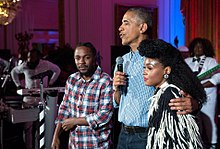
Early works of progressive rap such as the 1982Grandmaster Flash and the Furious Fivesong "The Message"and the music ofPublic Enemyfeatured expressions of anger about chaoticurban life.[62][63]Other formative groups such asDe La Soul,A Tribe Called Quest,andBrand Nubianhelped establish the genre's thematic mode.[64]At the turn of the 2000s,OutkastandThe Rootswere among the few progressive-rap acts who "ruminated on hip-hop'spost-millennialdirection "and" produced records in an avant-garde vein purposely intended to evolve the music "while achieving commercial success, according toMiles Marshall Lewis.[65]Kanye West,another influential artist in hip hop's progressive tradition, achieved even greater success with his opening trilogy of education-themed albums in the 2000s.[66]His 2010 albumMy Beautiful Dark Twisted Fantasyhas also been associated with prog-rap due largely to itssamplingof records from progressive rock as well as its ostentatious sensibilities.[67]
The UK has also produced notable performers in progressive rap, includingGaikaandKojey Radical,who are credited byVicein 2016 for working "deliberately outside the confines ofgrimeand traditional UK hip hop to create genuinely progressive rap that rivals the US for creativity, urgency, and importance, and portrays a much broaderblack British musiclandscape than you hear on the radio ".[68]More recently, American studies and media scholar William Hoynes highlights the progressive rap ofKendrick Lamaras being in the tradition of African-American art and activism that operated "both inside and outside of the mainstream to advance a counterculture that opposes the racist stereotypes being propagated in white-owned media and culture".[69]
Notes
[edit]- ^According to academic Tim Wall, the most significant example of the struggle betweenTin Pan Alley,African American,vernacular and art discourseswas in jazz. As early as the 1930s, artists attempted to cultivate ideas of "symphonic jazz", taking it away from its perceived vernacular and black American roots. These developments succeeded in the respect that many people today no longer consider certain forms of jazz as popular music.[13]
- ^The term was also partly related toprogressive politics,but those connotations were lost early in the 1970s.[18]
- ^Starting in about 1967, "pop music" was increasingly used in opposition to the term "rock music", a division that gave generic significance to both terms.[20]
- ^Allan Moore writes; "It should be clear by now that, although this history appears to offer a roughly chronological succession of styles, there is no single, linear history to that thing we callpopular song.[...] Sometimes it appears that there are only peripheries. Sometimes, audiences gravitate towards a centre. The most prominent period when this happened was in the early to mid 1960s when it seems that almost everyone, irrespective of age, class or cultural background, listened to the Beatles. But by 1970 this monolothic position had again broken down. Boththe Edgar Broughton Band's 'Apache Dropout' andEdison Lighthouse's 'Love grows' were released in 1970 with strong Midlands/London connections, and both were audible on the same radio stations, but were operating according to very different aesthetics. "[25]
- ^This situation fell in disuse after the late 1970s and would not reemerge until the rise ofInternetstars.[29]
- ^TheNew Popmovement of the 1980s was an attempt to bridge this divide.[30]
- ^By 1970, a journalist atMelody Makerhighlighted progressive pop as the "most fascinating and recent development" in popular music, writing that the music is "meant for a wide audience but which is intended to have more permanent value than the six weeks in the charts and the 'forget it' music of older pop forms".[33]
- ^Author Doyle Greene believes that the "proto-prog" label can stretch to "the laterBeatlesandFrank Zappa",Pink Floyd,Soft Machine,andUnited States of America.[36]Edward Macan says that psychedelic bands like the Nice, the Moody Blues, and Pink Floyd represent a proto-progressive style and the first wave of English progressive rock.[35]
- ^Groups such asthe Sex Pistols,the Clash,and theRamonesadopted a "back-to-basics" stance, embracing the roots of rock music with direct sentiments, simple chord structures, and uncluttered arrangements.[41]While punk rock appeared to be a negation of progressive rock, both styles of music derived from the idea of a cultural alternative.[6]
References
[edit]Citations
- ^ab"Progressive Jazz".AllMusic.
- ^Willis 2014,p. 219, 'Progressive' music can be seen as an experimentation with alternative routes ";Moore 2004,p. 22, "What was so revolutionary about this post-hippie music that came to be called 'progressive'... was that... the umbilical link between idiolect and style had been broken.";Macan 1997,p. 246, "the progressive rock of the 1970s had been 'progressive' only as long as it pushed the stylistic and conceptual boundaries of rock outwards"
- ^abcHolm-Hudson 2013,p. 85.
- ^Guern 2016,p. 33;Martin 1998,p. 41.
- ^Holm-Hudson 2013,pp. 85–87.
- ^abMacan 2005,p. 250.
- ^Reynolds 2013,pp. 6–7, 16.
- ^Holm-Hudson 2013,pp. 16, 85–87.
- ^abCotner 2000,p. 90.
- ^Cotner 2000,p. 93.
- ^abcAllan F. Moore (1 Apr 2016).Song Means: Analysing and Interpreting Recorded Popular Song.Routledge. p. 202.ISBN978-1-317-05265-4.
- ^abcdAke, Garrett & Goldmark 2012,p. 131.
- ^Wall 2013,pp. 42–43.
- ^Butler 2002,pp. 103–105.
- ^Gillespie 2009,p. 337.
- ^"Progressive Big Band".AllMusic.
- ^ab"Prog-Rock".AllMusic.
- ^Robinson 2017,p. 223.
- ^abMoore 2004,p. 22.
- ^Gloag, Kenneth (2006). Latham, Alison (ed.).The Oxford Companion to Music.Oxford: Oxford University Press.ISBN0-19-866212-2.
- ^Haworth & Smith 1975,p. 126.
- ^Moore 2016,pp. 201–202.
- ^Hewitt & Hellier 2015,p. 162.
- ^Moore 2016,p. 201.
- ^Moore 2016,pp. 199–200.
- ^Edmondson 2013,p. 890.
- ^Willis 2014,p. 219.
- ^Willis 2014,p. 217.
- ^Moore 2016,p. 202.
- ^abReynolds 2006,p. 398.
- ^Frith & Horne 2016,p. 99.
- ^Frith & Horne 2016,pp. 74, 99–100.
- ^Jacobshagen, Leniger & Henn 2007,p. 141.
- ^Priore 2005,p. 79.
- ^abHolm-Hudson 2013,p. 84.
- ^abGreene 2016,p. 182.
- ^Macan 2005,p. 75.
- ^Macan 1997,p. 23.
- ^Macan 2005,p. xxiii.
- ^Hegarty & Halliwell 2011,p. 224.
- ^abcdeRojek 2011,p. 28.
- ^abcCovach 1997,p. 5.
- ^Macan 1997,p. 206.
- ^Greene 2014,p. 173.
- ^Martin 1998,p. 251.
- ^Keister 2019,p. 20;Martin 1998,p. 41.
- ^Politis 1983,p. 81;Martin 1998,p. 41;Hoard & Brackett 2004,p. 524.
- ^Hoard & Brackett 2004,p. 524.
- ^Himes 1990.
- ^Keister 2019,p. 9.
- ^Keister 2019,pp. 9–10.
- ^Keister 2019,p. 10.
- ^"Progressive Electronic".AllMusic.
- ^Epstein, Dan."50 Greatest Prog Rock Albums of All Time".Rolling Stone.Retrieved18 February2022.
- ^Reynolds 2013,pp. 7, 16.
- ^Reynolds 2013,p. 184.
- ^Reynolds 2013,p. 376.
- ^Potter & Gann 2016,p. 178.
- ^abReynolds 2013,p. 50.
- ^Reynolds 2013,pp. 6–7.
- ^Reynolds 2013,p. 386.
- ^abPinn, Anthony(2005)."Rap Music and Its Message".In Forbes, Bruce; Mahan, Jeffrey H. (eds.).Religion and Popular Culture in America.University of California Press.pp. 262–263.ISBN9780520932579.RetrievedMarch 1,2021– viaGoogle Books.
- ^abParker, Evelyn L. (2003).Trouble Don't Last Always: Emancipatory Hope Among African American Adolescents.Pilgrim Press.ISBN9780829821031.
- ^Tate, Greg(2004). "Diatribe". In Cepeda, Raquel (ed.).And It Don't Stop: The Best American Hip-Hop Journalism of the Last 25 Years.Farrar, Straus and Giroux. p. 155.ISBN9781466810464.
- ^Lewis, Miles Marshall(August 9, 2007)."Common".Dallas Observer.RetrievedJuly 14,2021.
- ^Hussain, Shahzaib (November 23, 2008)."Renegade Man: The Legacy of Kanye West's '808s & Heartbreak'".Highsnobiety.RetrievedJuly 16,2021.
- ^Deville, Chris (November 20, 2020)."Kanye West 'My Beautiful Dark Twisted Fantasy' 10th Anniversary Review".Stereogum.RetrievedMarch 1,2021.
- ^Vinti, Mike (January 29, 2016)."Beyond Grime: Why You Need to be Paying Attention to Britain's Other Rap Scenes".Vice.RetrievedMarch 1,2021.
- ^Croteau, David; Hoynes, William; Childress, Clayton (2021).Media/Society: Technology, Industries, Content, and Users.SAGE Publications.p. 274.ISBN9781071819319.
Sources
- Ake, David Andrew; Garrett, Charles Hiroshi; Goldmark, Daniel (2012).Jazz/not Jazz: The Music and Its Boundaries.University of California Press.ISBN978-0-520-27103-6.
- Butler, David (2002).Jazz Noir: Listening to Music from Phantom Lady to The Last Seduction.Greenwood Publishing Group.ISBN978-0-275-97301-8.
- Cochrane, Naima (March 26, 2020)."2000: A Soul Odyssey".Billboard.RetrievedJanuary 23,2021.
- Cotner, John S. (2000)."Music Theory and Progressive Rock Style Analysis".Reflections on American Music: The Twentieth Century and the New Millennium.Pendragon Press.ISBN978-1-57647-070-1.
- Covach, John (1997)."Progressive Rock, 'Close to the Edge', and the Boundaries of Style"(PDF).In John Covach; Graeme M. Boone (eds.).Understanding Rock: Essays in Musical Analysis.New York: Oxford University Press.
- Easlea, Daryl (2018). "18: The Tremble in the Hips:So".Without Frontiers: The Life & Music of Peter Gabriel(Revised and Updated ed.). Omnibus Press.ISBN978-1-787-59082-3.
- Edmondson, Jacqueline, ed. (2013).Music in American Life: An Encyclopedia of the Songs, Styles, Stars, and Stories that Shaped our Culture.ABC-CLIO.ISBN978-0-313-39348-8.
- *Frith, Simon;Horne, Howard (2016) [First published 1988].Art Into Pop.Routledge.ISBN978-1-317-22803-5.
- Gillespie, Dizzy(2009).To Be, Or Not-- to Bop.University of Minnesota Press.ISBN978-0-8166-6547-1.
- Green, Tony (March 2002)."Joi: Star Kity's Revenge (Universal)".Spin.RetrievedJanuary 23,2021– viaGoogle Books.
- Greene, Doyle (2014).The Rock Cover Song: Culture, History, Politics.McFarland.ISBN978-1-4766-1507-3.
- Greene, Doyle (2016).Rock, Counterculture and the Avant-Garde, 1966–1970: How the Beatles, Frank Zappa and the Velvet Underground Defined an Era.McFarland.ISBN978-1-4766-2403-7.
- Guern, Philippe Le (2016).Stereo: Comparative Perspectives on the Sociological Study of Popular Music in France and Britain.Routledge.ISBN978-1-317-05001-8.
- Haworth, John Trevor; Smith, Michael A. (1975).Work and Leisure: An Interdisciplinary Study in Theory, Education and Planning.Lepus Books.ISBN9780860190097.
- Hegarty, Paul;Halliwell, Martin (2011).Beyond and Before: Progressive Rock Since the 1960s.New York: The Continuum International Publishing Group.ISBN978-0-8264-2332-0.
- Hoard, Christian; Brackett, Nathan, eds. (2004).The New Rolling Stone Album Guide.Simon & Schuster.ISBN9780743201698.
- Holm-Hudson, Kevin, ed. (2013).Progressive Rock Reconsidered.Routledge.ISBN978-1-135-71022-4.
- Hewitt, Paolo; Hellier, John (2015).Steve Marriott: All Too Beautiful.Dean Street Press.ISBN978-1-910570-69-2.
- Himes, Geoffrey (May 16, 1990)."Records".The Washington Post.RetrievedJanuary 26,2021.
- Himes, Geoffrey(October 12, 2011)."Bilal '1st Born Second'".The Washington Post.RetrievedJanuary 23,2021.
- Jacobshagen, Arnold; Leniger, Markus; Henn, Benedikt (2007).Rebellische Musik: gesellschaftlicher Protest und kultureller Wandel um 1968.Verlag Dohr.ISBN978-3-936655-48-3.
- Keister, Jay (2019)."Black Prog: Soul, Funk, Intellect and the Progressive Side of Black Music of the 1970s"(PDF).American Music Research Center Journal.28.RetrievedJanuary 26,2021– viacolorado.edu.
- Macan, Edward (1997).Rocking the Classics: English Progressive Rock and the Counterculture.Oxford University Press.ISBN978-0-19-509887-7.
- Macan, Edward (2005).Endless Enigma: A Musical Biography of Emerson, Lake and Palmer.Open Court.ISBN978-0-8126-9596-0.
- Martin, Bill(1998).Listening to the Future: The Time of Progressive Rock.Chicago: Open Court.ISBN0-8126-9368-X.
- Moore, Allan (2004).Jethro Tull's Aqualung.Bloomsbury Publishing.ISBN978-1-4411-1315-3.
- Moore, Allan F. (2016).Song Means: Analysing and Interpreting Recorded Popular Song.Routledge.ISBN978-1-317-05265-4.
- Politis, John (1983). "Rock Music's Place in the Library".Drexel Library Quarterly.19.
- Potter, Keith; Gann, Kyle (2016).The Ashgate Research Companion to Minimalist and Postminimalist Music.Routledge.ISBN978-1-317-04255-6.
- Priore, Domenic(2005).Smile: The Story of Brian Wilson's Lost Masterpiece.London: Sanctuary.ISBN1860746276.
- Reynolds, Simon(2006). "New Pop and its Aftermath".On Record: Rock, Pop and the Written Word.Routledge.ISBN978-1-134-93951-0.
- Reynolds, Simon(2013).Generation Ecstasy: Into the World of Techno and Rave Culture.Routledge.ISBN978-1-136-78316-6.
- Robinson, Emily (2017).The Language of Progressive Politics in Modern Britain.Palgrave Macmillan UK.ISBN978-1-137-50664-1.
- Rojek, Chris (2011).Pop Music, Pop Culture.Polity.ISBN978-0-7456-4263-5.
- Wall, Tim (2013).Studying Popular Music Culture.SAGE Publications.ISBN978-1-4462-9101-6.
- Willis, Paul E.(2014).Profane Culture.Princeton University Press.ISBN978-1-4008-6514-7.
Further reading
[edit]- Gendron, Bernard (2002).Between Montmartre and the Mudd Club: Popular Music and the Avant-Garde.University of Chicago Press.ISBN978-0-226-28735-5.
- Official Charts Company(September 4, 2015)."Progressive music you didn't know you loved".Official Charts Company.
- Romano, Will (2014).Prog Rock FAQ: All That's Left to Know About Rock's Most Progressive Music.Backbeat Books.ISBN978-1-61713-620-7.
- Smith, Bradley (1997).The Billboard Guide to Progressive Music.Billboard Books.ISBN978-0-8230-7665-9.
